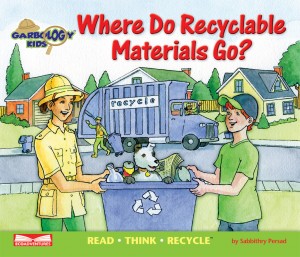An agent once told me that a good way to break into the [tough] picture book market is to write a non-fiction title. Today Sabbithry Persad drops by to tell us about how she not only broke into publishing, but how she’s thriving with a non-fiction series she self-publishes and markets to the education market. Stick around to learn about the process and rewards of non-fiction writing for children! And if you have a question for Sabbithry, please leave a comment for her.

Sabbithry, where was the idea for Garbology born?
The idea for the book came about around 2008 after reading an article on the world’s waste problem. At that time, we were already trying to bring environmental solutions to adults through our online magazine (Green Solutions Magazine) and thought it would be great to do something for children, so I wrote a story for my niece and nephew that evening. It wasn’t until a year or so later when I learned about Dr. William Rathje, an archeologist who formulated the science of Garbology some 38 years before, that the idea came to life. When I read up on Dr. Rathje’s work studying refuse of modern society (versus the study of refuse from past societies), it made sense to call the series “Garbology Kids™,” recognizing and honoring Dr. Rathje and his work.
 How did you research publishers?
How did you research publishers?
At first, I initially wrote the book and sent it out to several publishers, who I found in my locale through publishing associations. Of course, like everyone else, once I sent out the manuscript, it took a very long time (more than six months) to receive the first four or five rejection letters back, which had been somewhat discouraging, too (smiles), but I kept at it and went in an untraditional direction (which, with the changing publishing industry, is proving not so untraditional anymore). I eventually started my own publishing company for the magazine I founded and decided to publish the book under it. I look at it as a curve ball that turned into a rewarding passion (laughs). And after two years, I’m now looking back on all the work I’ve put in and feeling that it was all worth it.
How have you been marketing the series? Did you tie it into school curriculum or do anything else to appeal specifically to teachers and educators?
Before I started editing the book, I knew right away I wanted it to be an educational tool. So during the writing process, I kept in line with several environmental education guidelines for both Canada and the US, which were what schools followed. Once the writing was done and I felt that the book was ready factually, I passed it by several experts in the industry to make sure that the information was accurate and met with varying experiences and perspectives, not just in North America, but also from the UK, Germany and Australia.
What are the specific challenges of selling to the school/education market?
I think the first thing one needs to think about before selling anything is producing a good product. In the case of my book, that meant relevant material for children, parents and teachers (and anyone else interested in the topic). Most of my time and energy was spent writing, editing, rewriting, re



